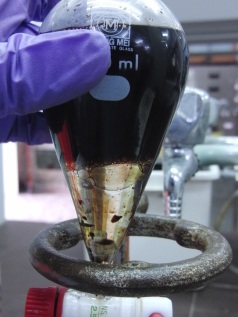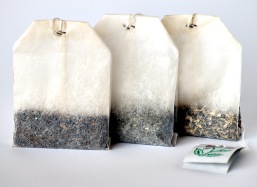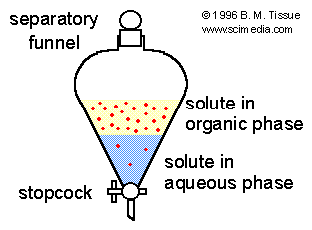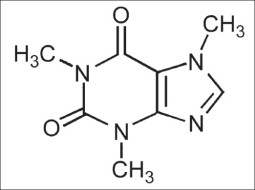For a recent Organic Chemistry Lab, I learned how to do an extraction. Extraction is a process used to remove a desired compound from a solid or a liquid mixture using a suitable solvent. It is never possible to completely extract or remove a compound from a given solvent; ideally very little impurity will be left behind. There are three types of extraction; solid/liquid, liquid/liquid, and acid/base extraction. Solid liquid involves the removal of a substance from a natural product or solid mixture (ie. hot water and tea/coffee). Liquid/liquid extraction involves the transfer of the desired compound from one liquid to another. Often times, a substance is soluble in water, but much more soluble in a different solvent (usually organic) so the compound becomes dissolved in the second organic solvent. Last is acid/base extraction in which an acid (H3O+) or base (OH-) is added to a mixture causing an unwanted impurity to react and become a solid. This solid is easily filtered out.
 For my lab, our goal was to extract caffeine from tea. We first placed 10 tea bags in boiling water, establishing the aqueous phase and the caffeine dissolved into the water along with impurities. Hot water is much more efficient at dissolving caffeine then colder water. This is an example of solid/liquid extraction. Next, we performed an acid/base extraction by adding sodium carbonate (a base) which reacted with an impurity, called tannins, and caused the tannins to become a solid. We then added the water-tea mixture to a separatory funnel (pictured to the left) and added dichloromethane (DCM). DCM is an organic solvent and caffeine is much more soluble in it than compared to water. In turn, the caffeine dissolves into the DCM, which can be extracted later. After adding the DCM, the funnel must be rocked back and forth to mix the solvents. Since water and DCM have differing densities, they separate after being allowed to rest. DCM is denser than water. The funnel must be vented to avoid pressure buildup. The “bubbles” in the bottom of the funnel is an emulsion, which occurs when a liquid is dissolved in another liquid, in this case it is water and DCM.
For my lab, our goal was to extract caffeine from tea. We first placed 10 tea bags in boiling water, establishing the aqueous phase and the caffeine dissolved into the water along with impurities. Hot water is much more efficient at dissolving caffeine then colder water. This is an example of solid/liquid extraction. Next, we performed an acid/base extraction by adding sodium carbonate (a base) which reacted with an impurity, called tannins, and caused the tannins to become a solid. We then added the water-tea mixture to a separatory funnel (pictured to the left) and added dichloromethane (DCM). DCM is an organic solvent and caffeine is much more soluble in it than compared to water. In turn, the caffeine dissolves into the DCM, which can be extracted later. After adding the DCM, the funnel must be rocked back and forth to mix the solvents. Since water and DCM have differing densities, they separate after being allowed to rest. DCM is denser than water. The funnel must be vented to avoid pressure buildup. The “bubbles” in the bottom of the funnel is an emulsion, which occurs when a liquid is dissolved in another liquid, in this case it is water and DCM.
The DCM is the desired solvent to be harvested in our extraction because it has the majority of caffeine dissolved in it. The DCM extract is collected from the funnel and more DCM is added and the process is repeated as a second extraction. This increases our overall yield. After the second mixture of DCM is collected, calcium chloride is added to the mixture, which is a drying agent; it absorbs water from the mixture. Lastly, the mixture is heated over a steam bath to evaporate the DCM because we desire only the solid caffeine. To analyze our results, the solid caffeine is weighed to find the percent of recovery, and the melting point of our sample is found to be compared with the known value. Ideally, we want a high percent recovery and melting point range similar to the known value. An accurate melting point signifies that the sample is pure, which is desired in our experiment.



October 2, 2014 at 9:54 am
Thanks for writing this! You just helped a Biotechnology major with her organic chemistry lab 🙂
April 16, 2015 at 10:16 am
I second the last comment! You just helped an IB student with her extended essay in chemistry! Thanks a million ~ I really needed this pithy alternative to my proposed lab!